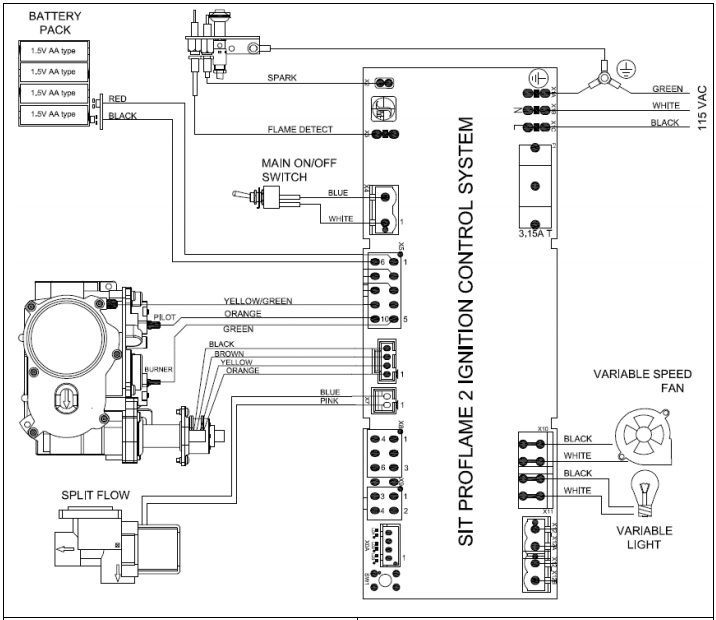How Electronic Ignition (IPI) Fireplaces Work

In a previous post, we talked about how gas fireplaces work in simple terms, which covers what is called a millivolt gas fireplace system.
To summarize that post, a millivolt system works like this:
- Gas flows into a series of valves attached to your gas fireplace.
- The valves are always closed unless something opens it. This prevents gas from flowing into your home when the fireplace is not lit.
- A device called a thermocouple will hold open the pilot light valve as long as the pilot light is lit.
- The larger valve for your main burner is controlled by a wall switch or remote control. This larger valve will not open until the remote or wall switch is set to on.
IPI Stands For Intermittent Pilot Ignition – An update to the classic standing pilot light.
A key feature of a standard millivolt system is that the pilot light is always running, even when the fireplace is off. This is called a standing pilot light, and it ensures that whenever you are ready to turn the fireplace on and enjoy some flames, your pilot light can light the main burner. The entire millivolt system requires no external power source, and it all relies on the pilot light running. But if the pilot light is always running, doesn’t that waste gas? Enter the new electronic ignition systems for your gas fireplace.
A standing pilot light that runs 24/7 will cost you an estimated $.60 per day, depending on the gas prices in your area. That’s just under $20 a month, or $75 per season. With the new IPI systems, that cost is almost entirely eliminated.
Fireplaces Get Smart
For a while, it looked like natural gas prices might skyrocket, and so manufacturers put their heads together to come up with a way to ensure that the only time your pilot light is on is when the fireplace is running. To do this, they needed to solve a couple of problems. First, they would need a way to ignite the pilot light and the main burner, without someone having to get up and push a button. In order to do that (in a modern way) they would need to integrate a circuit board or control module to be smart enough to open and close the gas valves on-demand and create a spark. Lastly, to use that circuit board they would need a pretty decent amount of power. Once these problems were solved, the manufactures could add all sorts of extras, such as remotes, thermostats, burner settings and more – all controlled through the ‘computer’ inside your fireplace.
How It Works
To make it really simple, a modern electronic ignition fireplace that is set to IPI mode goes through the following steps:
- Gas flows into the fireplace but all valves are closed, including the pilot light valve.
- When the fireplace gets a ‘call to heat’, likely from a homeowner pressing the ‘on’ button on the remote, it sends a signal to a control board which puts the fireplace into a start-up sequence.
- The pilot light valve is opened letting a small amount of gas flow.
- An electronic igniter uses a small amount of electricity to spark the pilot light.
- A sensor detects an active pilot flame.
- If all is good, the main burner valve opens, allowing gas to flow through to the main burners.
- The pilot light ignites the flame on the main burners. Voila! Flames
IPI VS Millivolt Gas Fireplaces
So what are the real differences between modern (IPI) and millivolt gas fireplaces?
- A millivolt system does not require any external power, and operates solely off of the pilot light being lit, whereas an electronic ignition system requires external power, usually a standard electrical outlet.
- The pilot light of a millivolt system must initially be lit by a piezo sparker or match to get the pilot light going, after that, wall switches and remotes can do their thing. However, with an electronic ignition system, as long as it has power, the pilot light is light on call for heat from a remote
- A modern electronic ignition system uses a control board (computer board) to control the gas valves, whereas a millivolt system uses technology from 1821 called a thermocouple
The real difference is a simple sentence is: A modern gas fireplace has the ability to ignite without the pilot light running, which keeps your gas bill lower throughout the heating season.
Using Your Fireplace In A Power Outage
Another false claim going around the internet is that modern gas fireplaces do no work in a power outage, but millivolt systems do. This does not have to be true. A battery backup can be purchased for most modern systems that will ensure you can still use your electronic ignition fireplaces in the event of a power outage. The battery simply acts as a power source while the power is out.
CPI Mode On Modern Gas Fireplaces
Many fireplace manufacturers have included a feature in newer fireplaces that allow them to be set to CPI or continuous pilot ignition mode. The reasons for this are simple and indicative of a problem: Electronic ignitions sometimes fail to work on a start-up sequence. This rarely happens, and it is no fault of the fireplace manufacturers. The reason for this is because of the gas itself. As the gas sits in the line for a long period of time, air can push ahead of it, causing the first couple of attempts to call for heat to not work. This generally happens after a period of long activity. Also, some customers are not concerned with the $75 per season it may cost to run a pilot light continuously. In addition to these reasons, a standing pilot light can keep a draft in your chimney/vent, reduce condensation, and keep snow off any cap you may have where the vent terminates. From one of the Mendota owners manuals:
“Mendota recommends that CPI mode is used during the winter months when the average daily high temperature falls below 50° F. This will keep the fireplace chimney heated for proper updraft during burner ignition, and it will also eliminate excessive condensation of exhaust vapors on the door glass. Leaving the fireplace in CPI mode will keep the fireplace body warm and eliminate cold drafts and heat loss to the cold air that is trapped inside the firebox.”
Summary
An IPI gas fireplace does not require the pilot light to run all the time. It uses a control board and an external power source to electronically ignite the burners and operate the gas valves. You don’t have to worry about “what if my pilot light goes out” scenarios. The introduction of a control board into a modern gas fireplace will certainly provide additional options in the future, such as voice-controlled fireplaces.
The post How Electronic Ignition (IPI) Fireplaces Work appeared first on Chimney Works & Rocky Mountain Stoves.
Search the Outpost





